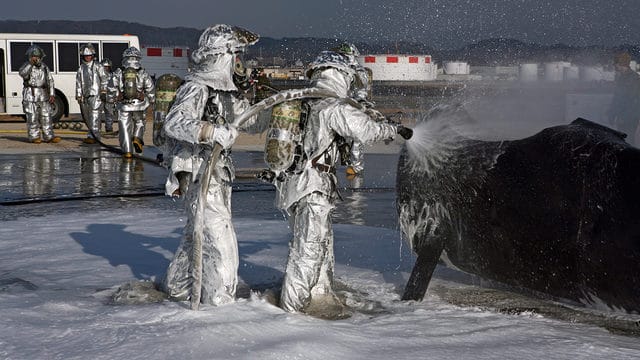

In the late 1960s and early 1970s, the armed forces began employing aqueous film-forming foam (AFFF) on many U.S. military bases, a fire-extinguishing solution designed by the Navy in collaboration with 3M to quickly snuff out difficult blazes. The foam’s remarkable surfactant qualities were the result of the per and polyfluoroalkyl substances (PFAS) within, a class of over 12,000 synthetic carbon-fluorine compounds whose molecular strength prevents natural decay, earning them the unofficial name of “forever chemicals.” The first formulations primarily included two PFAS subtypes, perfluorooctanoic acid (PFOA) and perfluorooctane sulfonic acid (PFOS).
Manufacturers withheld this information.
While the foam’s manufacturers upheld their stance that both compounds were inert ingredients, internal corporate documents going back decades show that not only were they aware of potential health hazards, they also withheld this information from federal authorities and the general public.
Mounting clinical and environmental research has found that PFAS are persistent contaminants that bioaccumulate in bodily tissues and blood. Exposure has been linked to elevated cancer risks, liver enzyme changes, birth weight decreases and more.
The EPA developed guidelines in 2016, which limited safe PFOA and PFOS concentrations in drinking water to 70 parts per trillion (ppt). However, PFAS contamination is suspected or confirmed on over 700 U.S. military installations, including 62 in California.
In Monterey County, AFFF is known to have been used on the former Fort Ord and Fort Hunter Liggett. Testing conducted in 2019 found that PFOA and PFOS concentrations in Fort Ord’s groundwater totaled 560 ppt, while the highest detections in Fort Hunter Liggett’s groundwater were 1,600 ppt (PFOA) and 5,000 ppt (PFOS).
Chemical manufacturers’ cover-up of health risks meant that military firefighters who used the foam in its heyday didn’t employ appropriate safety and preventive measures to mitigate exposure.
The bipartisan PACT Act in 2022 was touted as the most important development in years, promising to address a broad range of toxic exposure issues affecting former service members. However, the VA still doesn’t recognize military firefighters’ exposures to forever chemicals as a presumptive service-related factor that would automatically qualify them for benefits and compensation.
That means veterans filing for VA disability first have to prove […]
Full article: www.montereycountyweekly.com
Clean water is essential for life, yet millions of Americans unknowingly consume contaminants through their…
Human brains contain higher concentrations of microplastics than other organs, according to a new study, and the…
From the Office of the Governor: In anticipation of a multi-day, significant atmospheric river in Northern California,…
From Governor Newsom: Scientists, water managers, state leaders, and experts throughout the state are calling…
Photo: A harmful algal bloom in Milford Lake, Kansas, made the water appear bright green.…
An expanded plastic foam coffee cup is at a donut shop in Monterey Park, California.…